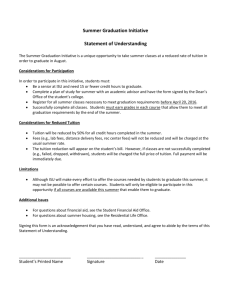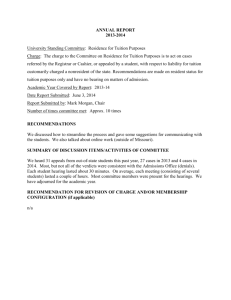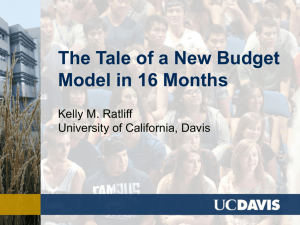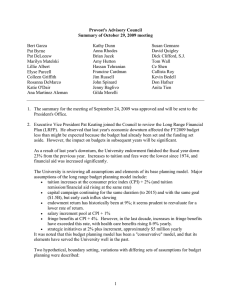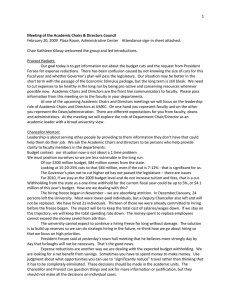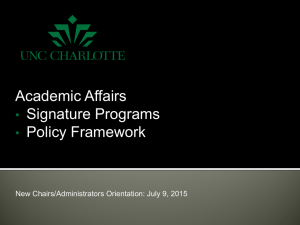WSU Academic Affairs - Weber State University
advertisement
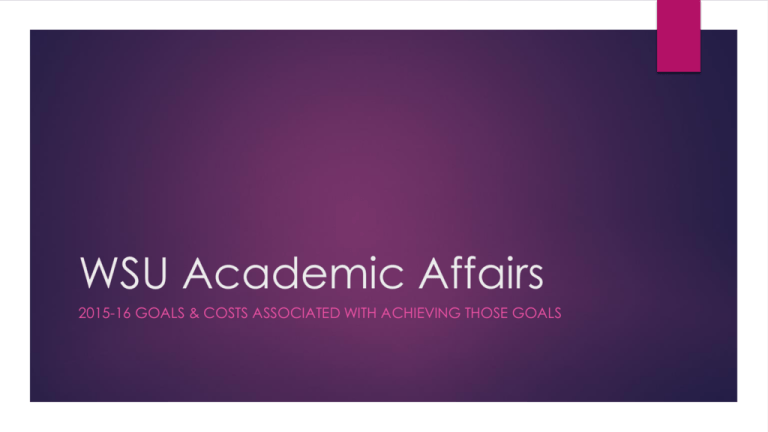
WSU Academic Affairs 2015-16 GOALS & COSTS ASSOCIATED WITH ACHIEVING THOSE GOALS Goal One IMPROVE GRADUATION RATES BY ESTABLISHING A MORE PROACTIVE, MORE OBVIOUS “CULTURE OF COMPLETION” ACROSS CAMPUS I.1 Components of a Culture of Completion Make Orientation mandatory for first-time, fulltime students at WSU; fill current sessions to capacity; add at least one more session Include “confidence building” video; Cost: $24K 1.2 Degree Maps Ensure that all programs have degree maps. Currently, ~38 programs do so; ~200 need to complete maps. Cost: personnel time. 1.3 Early Alert Referral System Last year, faculty and staff referred 1,038 students to EARS, the Early Alert Referral System. This coming year, Academic Affairs will publicize the availability of EARS, thereby increasing the system’s use. Cost: materials and time associated with PR and marketing. $5,000 1.4 Personally contact students close to graduation Provide advisors and faculty members with contact info on students who are within two semesters’ of completion. Establish incentives for timely completion. Cost: preparation and personal contact time; whatever incentives we offer. 1.5 Summer Scholarships for those close to graduation Offer the 120 students who have completed 70 to 74% of their requirements (and completed at least 70% of their major)a scholarship for summer tuition to graduate by summer’s end. Cost: $267,335; or half tuition = $133,663. 1.6 Make ‘student success’ part of faculty hiring In both application documents and candidate visits, include questions about candidates’ commitment to student retention and completion. Cost: time associated with establishing these practices as part of the hiring process. Goal Two ANALYZE AND REMEDY BOTTLENECKS THAT STOP STUDENTS ON THE PATH TOWARD COMPLETION 2.1 Quantitative Literacy Work with new High School Math requirements, Developmental Math, General Education committees, and Math faculty to determine reasonable pathways for student success in quantitative literacy. Hire four Science/Math Education faculty. Cost: much time, energy, blood, and $400,000. 2.2 Summer Bridge Course Especially for students who are not collegemath-ready, offer an intensive summer bridge class. Cost: pilot program with class of 30, covering tuition & fees, books, instructor = $40,000. Goal Three EMPLOY PREDICTIVE ANALYTICS TO IDENTIFY STUDENTS WHO MAY BENEFIT FROM INTERVENTIONS TO HELP GET THEM TO COMPLETION. 3.1 Gather the data Make use of admissions data we currently have to discern patterns of need. Cost: time from data personnel. 3.2 Provide necessary intervention Address those needs with additional support resources (advising, FYE, small classes, etc.) Cost: support personnel; peer mentors = $100K. Goal Four DEPARTMENTAL LEADERSHIP 4.1 Empower chairs to lead Encourage creativity and change, especially with respect to curriculum and pedagogical practices. Foster more connections among chairs through periodic gatherings. Increase chair stipends. Cost: $124,440 Goal Five MEET WITH ALL DEPARTMENTS TO GET A SENSE OF STRENGTHS AND AREAS NEEDING DEVELOPMENT Meeting with departments The Provost will meet with each academic department in the university by the end of spring 2016. After this round of meetings, the Provost will develop a list of commendations and recommendations. Cost: time
